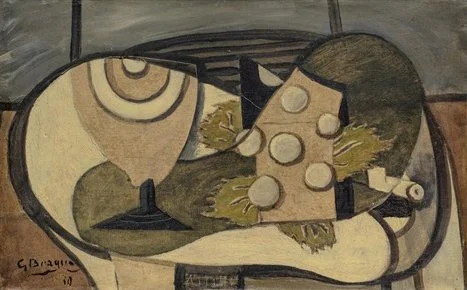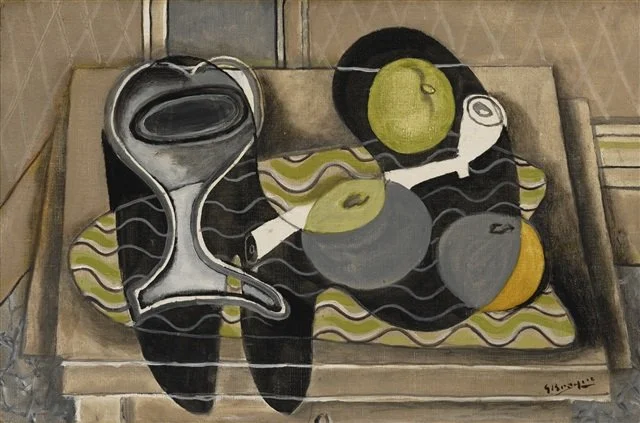GEORGES BRAQUE,
VERRE ET COMPOTIER, 1931
GEORGES BRAQUE
Verre et Compotier
signed, lower left GBRAQUE
oil on canvas
10.6 x 13.8 in. / 27 x 35 cm
painted in 1931
Provenance:
● Paul Rosenberg & Co., New York
● Reuben Freeman, Chicago
● Mr. and Mrs. Berny Schulman, Glencoe, Illinois
● Richard Feigen Gallery, Inc., Chicago 1964
Exhibited:
● Kunsthalle, Basel. Georges Braque, April–May 1933, No. 163
● Paul Rosenberg & Co., Georges Braque, an American Tribute. April–May 1964, New York, No. 5
● IVAM, Institut Valencià d’Art Modern, March 16 – May 7, 2006
Literature:
● C. Einstein, 20th century: Georges Braque. Paris 1934, p. XCII
● J. Richardson, Georges Braque. Paris 1961, p. 37
● Editions Galerie Maeght, Catalogue de l’oeuvre de Georges Braque 1928–1935, Paris 1962, p. 75
● Centre Georges Pompidou, Paris. Braque, p. 67
COMPARATIVE PAST AUCTIONS
-
Georges Braque, Verre et compotier
Medium : oil on canvas
Year of Work : 1931
Size : Height 10.6 in.; Width 13.7 in. / Height 27 cm.; Width 34.9 cm.
Signed
Sale of : Christie's New York: Wednesday, May 16, 1990 [Lot 00303]
Modern Paintings and Sculpture from the Douglas Collection
Estimate : 350,000 - 450,000 USD
Sold For : 330,000 USD Premium
Provenance :
Collection Kirk Douglas
Acquired at the above sale by the present owner.
source : ARTNET.COM -
Georges Braque, Les deux as
Medium : oil on canvas
Year of Work : 1929
Size : Height 9.6 in.; Width 13.8 in. / Height 24.3 cm.; Width 35 cm.
signed and dated 'G Braque 29' (lower left)
Sale of : Christie's London: Tuesday, June 27, 2017 [Lot 00002]
Impressionist & Modern Art Evening Sale
Estimate : 300,000 - 400,000 GBP (383,828 - 511,770 USD)
Sold For : 341,000 GBP Premium (436,284 USD)
Provenance :
Paul Rosenberg, Paris & New York, by 1938.
James Pendelton, New York.
E.V. Thaw & Co., New York.
Private collection, United States, by whom acquired in 1971; sale, Christie's, New York, 2 May 2006, lot 44.
Acquired at the above sale by the present owner.
source : ARTNET.COM -
Georges Braque, Verre et grappe de raisins
Medium : oil on canvas
Year of Work : 1930
Size : Height 8.7 in.; Width 13.9 in. / Height 22.2 cm.; Width 35.2 cm.
signed and dated 'G Braque 30' (lower left)
Sale of : Bonhams New York: Wednesday, May 14, 2025 [Lot 0017A] 20th/21st Century Art Evening Sale
Estimate : 150,000 - 250,000 USD
Sold For : 178,300 USD Premium
Provenance :
Ilka Chase Collection, New York.
Sale: Finarte, Rome, December 4, 1984, lot 153.
Acquired at the above sale by the present owner.
source : ARTNET.COM -
Georges Braque, Nature morte à la pipe
Medium : oil on canvas
Year of Work : 1932
Size : Height 10.6 in.; Width 16.1 in. / Height 27 cm.; Width 41 cm.
Signed
Sale of : Sotheby's New York: Tuesday, May 15, 2018 [Lot 00152] Impressionist & Modern Art Day Sale
Estimate : 400,000 - 600,000 USD
Sold For : 519,000 USD Premium
Provenance :
Private Collection, Berlin
Mrs. Alexandra Whitney, New York Mr. Harry P. Whitney, New York
Paul Rosenberg & Company, New York William Zierler, Inc., New York
Acquired from the above in 1972
source : ARTNET.COM
Verre et compotier
Les deux as
Verre et grappe de raisins
Nature morte à la pipe
source : ARTNET.COM
DOCUMENTATION
GEORGES BRAQUE, Verre et Compotier, 1931
The title of this work indicates the presence of two, central figurative elements, which are relatively identifiable despite not being realistic. On a dark brown table, a fruit bowl is seen both from above and in profile, with a glass also placed behind it. The background is the same colour as the table, added to by several thick, black, vertical strips.
The colour scheme relies on a contrast between light and dark. The forms in the foreground come across as mostly light; Braque uses white, several shades of grey, light pink (for the fruit bowl and on the table) and bright beige. These latter two shades bring a luminosity to the objects, which focusses our attention on them; this effect is accentuated by the contrast created with the dark tones of both the background and the table. Apart from those lightly filled areas of pink, the chromatic aspect of this painting lies largely in restrained, pared-down colouring; we do not get much colour, quite the opposite. Such limiting of colour is also apparent in other works Braque completed during the same period.
The forms themselves are surrounded by unmistakeable white and black lines painted on with a brush. This is the case around the fruit bowl, the glass and the table. These lines, though, seem to pervade the canvas’ space without necessarily carrying a specific function or representing any one thing. From there, they become a web of curves and counter-curves which spread across the entire surface, giving it a decorative and enigmatic feel. Certainly, it is possible that they are supposed to be some plant: a stem or vine or long, thin branches. However, in this painting, the visibility of the artist’s strokes and the freedom of expression he uses likely prevent the creation of such an illusionist outlook. The viewer is instead reminded of the flat, two-dimensionality of the painting. This use of curved lines and the arrangement of block colours in their own, uniform segments becomes more important to the work than the actual still life that it represents. The work’s make-up, on an artistic and textural level, is no longer just a means to an end (that end being the creation of a figurative image). Rather, that process itself becomes the painting’s very subject.
Contrary to the opinion of many art historians, we see that Georges Braque is, above all, a modern artist, not a Classical one.
Georges Braque’s Post Cubist Masterpieces, Anthem Edition, 2024.




